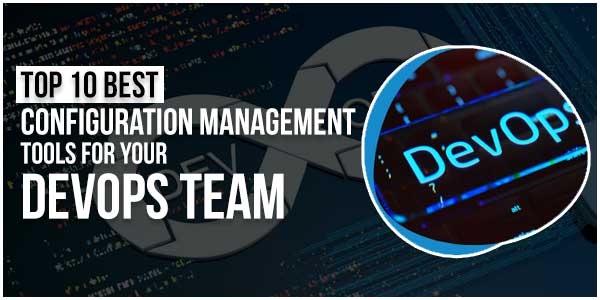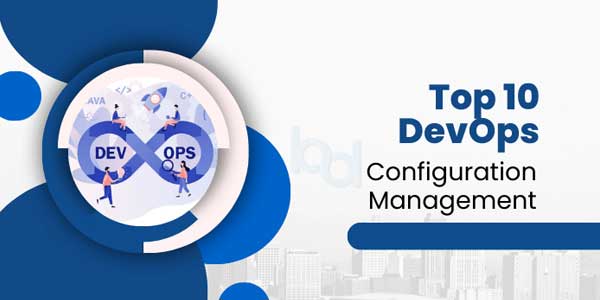
In the fast-paced world of DevOps, efficient management of configurations is key to success. As businesses strive for agility and reliability in their software development processes, selecting the proper configuration management tools becomes paramount. Whether you’re a seasoned DevOps team or just starting, finding the perfect fit can be overwhelming.
Fortunately, with the guidance of DevOps consulting services, navigating this landscape becomes much more straightforward. These services offer expertise and support in selecting, implementing, and optimizing configuration management tools tailored to your team’s unique needs.
From automating infrastructure provisioning to ensuring consistency across environments, the best configuration management tools empower teams to deploy code faster and with fewer errors. With features like version control, orchestration, and monitoring, these tools streamline workflows and enhance collaboration among developers, operations, and QA teams.
In this guide, we’ll explore some of the top configuration management tools favored by DevOps teams worldwide. By understanding their strengths and capabilities, you’ll be equipped to make informed decisions that drive efficiency and innovation within your organization. Let’s embark on this journey to elevate your DevOps practices and achieve more tremendous success together.
Table of Contents
Configuration Management Tools – Overview:
Configuration management tools are like magic wands for DevOps teams, making the complex world of software development much more straightforward. Picture this: you have a big project with many moving parts—servers, databases, code, you name it. Keeping track of all these pieces and ensuring they work together smoothly can be a real headache. That’s where configuration management tools swoop in to save the day.
Think of these tools as the organizers of the software universe. They help you keep everything in order, from setting up new servers to updating software across your entire system. With configuration management tools, you can automate repetitive tasks, ensuring consistency and reducing errors.
But that’s not all—they’re also like superheroes regarding collaboration. With these tools, your team can work together seamlessly, effortlessly sharing code, configurations, and updates. Plus, they provide a safety net, allowing you to roll back changes if something goes wrong.
Whether a small startup or a large enterprise, configuration management tools are your secret weapon for smoother, more efficient software development. So, buckle up and get ready to dive into the beautiful world of configuration management—it’s a game-changer for DevOps teams everywhere!
Advantages Of Configuration Management Tools:
Configuration management tools are like the Swiss Army knives of DevOps, offering many advantages that make life easier for developers, system administrators, and IT professionals.
Here’s a closer look at some of the key benefits:
- Automation: One of the most significant advantages of configuration management tools is automation. They allow you to automate repetitive tasks such as setting up servers, deploying applications, and configuring software. This saves time and reduces the risk of human error, leading to more reliable and consistent results.
- Consistency: With configuration management tools, you can ensure consistency across your infrastructure. Whether managing a single server or a complex network of machines, these tools help you maintain uniform configurations, reducing the chances of configuration drift and ensuring that your systems behave predictably.
- Scalability: As your infrastructure grows, so does the complexity of managing it. Configuration management tools scale with your needs, allowing you to manage thousands of servers and devices easily. This scalability is essential for businesses experiencing rapid growth or operating in dynamic environments.
- Version Control: Configuration management tools offer version control capabilities, allowing you to track changes to your infrastructure over time. This makes it easier to identify who made a change, when, and why, facilitating troubleshooting and auditing processes.
- Collaboration: These tools promote cooperation among team members by providing a centralized platform for managing configurations and sharing code. Team members can work together seamlessly, making changes collaboratively and sharing best practices.
- Security: By enforcing standard configurations and automating security policies, configuration management tools help enhance the security posture of your infrastructure. They can detect and remediate security vulnerabilities, enforce compliance with regulatory requirements, and ensure that security configurations are consistently applied across your environment.
- Flexibility: Configuration management tools offer flexibility in supporting various platforms, operating systems, and deployment models. Whether you’re deploying on-premises, in the cloud, or in hybrid environments, these tools provide the flexibility to adapt to your needs.

Top 10 Configuration Management Tools:
Here’s an overview of the top 10 configuration management tools:
Ansible:
Ansible is a user-friendly configuration management tool that automates tasks across your IT infrastructure. It operates over SSH, eliminating the need for agents on managed nodes. With simple YAML syntax, Ansible playbooks make defining configurations a breeze, perfect for beginners and experts. Its agentless architecture ensures fast and efficient operations, making it suitable for managing small to large-scale environments. Plus, Ansible fosters collaboration through its extensive library of modules and roles, empowering teams to automate and streamline their workflows effortlessly.
Puppet:
Puppet is a powerful configuration management tool that simplifies the management of your IT infrastructure. Using declarative language, Puppet allows you to define the desired state of your systems, making configuration changes easy to understand and implement. With its agent-based architecture, Puppet ensures consistent configurations across all nodes in your environment. It offers a vast ecosystem of modules and resources, enabling you to manage everything from servers to network devices seamlessly. Puppet is a go-to choice for organizations seeking automation, scalability, and reliability in their IT operations.
Chef:
Chef is a dynamic configuration management tool designed to simplify the management of your infrastructure. Using a Ruby-based DSL (Domain Specific Language), Chef allows you to define configurations and automate tasks easily. Its flexible approach supports agent-based and agentless modes, catering to various deployment scenarios. With features like cookbooks and recipes, Chef enables you to manage your infrastructure as code, making deployments consistent and reliable. Whether working in a small environment or a large-scale infrastructure, Chef empowers you to automate, collaborate, and scale efficiently.
SaltStack:
SaltStack is a robust configuration management tool that excels in speed and scalability. With its master-minion architecture, SaltStack enables you to manage and automate tasks across your entire infrastructure effortlessly. It offers a robust remote execution framework, allowing you to execute commands on multiple systems simultaneously. SaltStack’s highly customizable nature makes it suitable for managing large-scale environments with diverse requirements. Whether provisioning servers, configuring software, or enforcing security policies, SaltStack provides the flexibility and performance you need to streamline your operations effectively.
Terraform:
Terraform is a game-changing configuration management tool that brings your infrastructure to life through code. Terraform’s declarative language allows you to define and provision infrastructure resources across various cloud providers and platforms. Whether it’s setting up servers, networks, or databases, Terraform simplifies the process with its intuitive syntax and modular design. By treating infrastructure as code, Terraform enables you to effortlessly version, share, and collaborate on configurations. With its support for hybrid and multi-cloud environments, Terraform empowers teams to scale and manage infrastructure with unparalleled flexibility and efficiency.
CFEngine:
CFEngine is a trusted configuration management tool renowned for its stability and scalability. Using a policy-driven approach, CFEngine automates configuration management tasks across your infrastructure, ensuring consistency and reliability. It offers features like automated repair and drift detection, allowing you to maintain desired states effortlessly. CFEngine’s lightweight agents make it suitable for managing large-scale environments with minimal overhead. Whether enforcing compliance policies or deploying software updates, CFEngine provides the tools to streamline your operations efficiently.
AWS CloudFormation:
AWS CloudFormation is a fantastic configuration management tool that Amazon Web Services (AWS) provides. It lets you define and deploy your AWS infrastructure as code using simple templates. With CloudFormation, you can provision resources such as EC2 instances, databases, and networking components in a reliable and repeatable manner. Its template-based approach lets you version control your infrastructure configurations, making it easy to track changes and roll back deployments if needed. CloudFormation streamlines the process of managing complex AWS environments, empowering teams to automate deployments and maintain consistency effortlessly.
Google Cloud Deployment Manager:
Google Cloud Deployment Manager is a powerful configuration management tool that Google Cloud Platform (GCP) provides. It lets you define and manage your GCP infrastructure using declarative YAML or Python templates. With Deployment Manager, you can provision resources such as virtual machines, databases, and networking configurations consistently and automatically. Its template-based approach lets you version control your infrastructure configurations, making it easy to track changes and ensure reproducibility. Deployment Manager simplifies managing complex GCP environments, empowering teams to automate deployments and maintain infrastructure consistency effortlessly.
Azure Resource Manager (ARM):
Azure Resource Manager (ARM) is Microsoft Azure’s configuration management tool, designed to simplify the management of Azure resources. With ARM, you can define your infrastructure as code using JSON or Bicep templates, making it easy to provision and manage resources like virtual machines, databases, and storage accounts. ARM templates enable you to automate deployments and ensure consistency across your Azure environment. Its declarative syntax allows for version control and collaboration, empowering teams to streamline operations and improve efficiency. Whether deploying a single application or managing a complex cloud infrastructure, ARM provides the tools you need to automate and scale confidently.
Rudder:
Rudder is a user-friendly configuration management tool that simplifies managing IT infrastructure. It offers a web-based interface for defining and enforcing configurations across servers and devices in your environment. With Rudder, you can easily create policies to ensure compliance with security standards and best practices. Its automated reporting and drift detection features help you maintain desired configurations and identify any deviations. Rudder is an open-source tool that prioritizes simplicity and ease of use, making it ideal for small and large-scale deployments. Whether enforcing security policies or managing software updates, Rudder provides the tools to streamline configuration management efficiently.
Conclusion:
Selecting the right configuration management tool is vital for optimizing your DevOps practices and achieving success in today’s fast-paced digital landscape. Whether you opt for Ansible’s simplicity, Puppet’s declarative approach, or Terraform’s infrastructure-as-code capabilities, each tool offers unique benefits tailored to different organizational needs. By leveraging these tools, you can automate tasks, ensure consistency, and foster collaboration across your team, ultimately driving efficiency and innovation.
To fully harness the power of these tools, consider hiring DevOps engineers proficient in their implementation and optimization. DevOps engineers can help you select the best device for your requirements and ensure seamless integration with your existing infrastructure and workflows. With their expertise, your team can maximize the potential of configuration management tools, enabling you to stay ahead of the curve in today’s competitive market. So, invest in your DevOps team today and unlock the full potential of configuration management tools for your organization’s success.

 About the Author:
About the Author:
















I got know your article’s Content and your article skill both are always good. Thanks for sharing this article this content is very significant for me I really appreciate you.
you can read my blog here –
Welcome here and thanks for reading our article and sharing your view. This will be very helpful to us to let us motivate to provide you with more awesome and valuable content from a different mind. Thanks again.